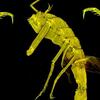Travel to the deepest depths of the ocean. Do you know what you’ll find there? Some of the most fascinating and bizarre creatures on Earth — some of them would give the things in nightmares, nightmares of their own! Back on dry land, there are about 10,000 species of reptiles roaming the Earth, from the tiny Jaragua lizard, to the largest, and longest, reticulated pythons.
How deep is the ocean? How about we travel down 26,000 feet with the Cordes Laboratory in the Biology Department at Temple University to find out? From zero to 70 feet, we might meet a Lion’s Mane Jellyfish, which can reach up to 120-feet long! Travel down between 660 and 3,300 feet, you might come across a Giant Oarfish, a real-life sea serpent (but it’s actually a fish) that can grow to 26-feet-long and weigh up to 600 pounds. Between 2,000 and 10,000 feet, you’ll find Deep-Sea Anglerfish — think nightmarish fangs and a bioluminescent lure protruding from their heads. Deep, deep down at 26,000 feet, say hello to the Snailfish, which survives in the depths of the Mariana Trench, which is 800 times more pressurized than the surface! Presented by Emily Cowell, Melissa Betters and April Stabbins, Cordes Laboratory, Biology Department.
Dive Into Horseshoe Crabs with Dr. Rob Jennings
Horseshoe crabs can look really scary! These “living fossils” might seem like they just crawled out of a sci-fi horror movie. Join Dr. Rob Jennings, Assistant Professor of Instruction in Biology and Laboratory Manager for Teaching Labs in the Biology Department at Temple University, on a quick tour of how they actually use those claws and spines, and you’ll learn that they are not only very friendly, they’re surprisingly important to their ecosystems— and they benefit humans in some unexpected ways!
Otherworldly Creatures in the Ocean's Deepest Depths
About 60 percent of the ocean is a cold, dark region that spans down to 11,000 meters. This zone is known as the deep ocean, and though it seems like an inhospitable and remote corner of the planet, it is actually one of the greatest habitats on Earth. In this video from TED-Ed, Lidia Lins explores how so many species thrive in this mysterious underwater world.
Elmwood Park Zoo — Macroinvertebrates
The Elmwood Park Zoo’s "Zoo School Live" provides a chance for everyone to meet some of the Zoo’s wonderful residents “up-close” virtually each week. In this video, we’re heading into the shallower waters of our local Pennsylvania waterways to study macroinvertabrates. These bottom-dwelling animals include crustaceans and worms but most are aquatic insects. Woody the wood turtle (who happens to be a reptile) also pays a visit! Video used with permission from the Elmwood Park Zoo.
Up Close with an American Alligator
Meet Penny the American Alligator! The American alligator is a rare success story of an endangered animal not only saved from extinction but now thriving. State and federal protections, habitat preservation efforts, and reduced demand for alligator products have improved the species' wild population to more than one million and growing today. You can visit Penny at the Elmwood Park Zoo! Video used with permission from the Elmwood Park Zoo.
All About Adaptations

Nesting in trees. Hanging from the roofs of caves. Borrowing deep underground. Living in some of the harshest climates on Earth. If there is one trait that all animals share, it is their ability to adapt. In this video, the Academy of Natural Sciences explores adaptations with the help of their resident ball python. The Academy of Natural Sciences provides Facebook Live experiences every Friday at 1 p.m. Ask questions in real-time virtually (all you need is a Facebook account)! Video provided with permission from the Academy of Natural Sciences.
Monsters of the Reptile Variety
Say hello to Napoleon and Dynamite, two Gila monsters that call the Elmwood Park Zoo home! The Gila monster is a species of venomous lizard native to the southwestern United States and the northwestern Mexican state of Sonora. A heavy, typically slow-moving lizard, the Gila monster is the only venomous lizard native to the United States and one of only two known species of venomous lizards in North America. Although the Gila monster is venomous, its sluggish nature means it represents little threat to humans. Video used with permission from the Elmwood Park Zoo.
Elmwood Park Zoo — Arizona Kingsnake
The Arizona kingsnake, in this case the Elmwood Park Zoo’s education ambassador Holmesssss, is very adaptable to a variety of different habitats from desert basins, to wetlands, to forests. The kingsnake will hibernate during the colder months of fall and winter. They have excellent climbing abilities and are often spotted in trees searching for birds or bird eggs. The Arizona kingsnake is non-venomous and cannot rattle. However, kingsnakes can tolerate rattlesnake venom and will often consume rattlesnakes as part of a meal. The Arizona kingsnake will bite a rattlesnake and use its coiling body to constrict the rattlesnake. Video used with permission from the Elmwood Park Zoo.
Get Ready to Tango!
This big guy is not a baby dinosaur or a crocodile, it’s Tango, the Agentine black and white tegu at the Elmwood Park Zoo. Learn all about Tango, from what he likes to eat to the baths he likes to take! Video used with permission from the Elmwood Park Zoo.

